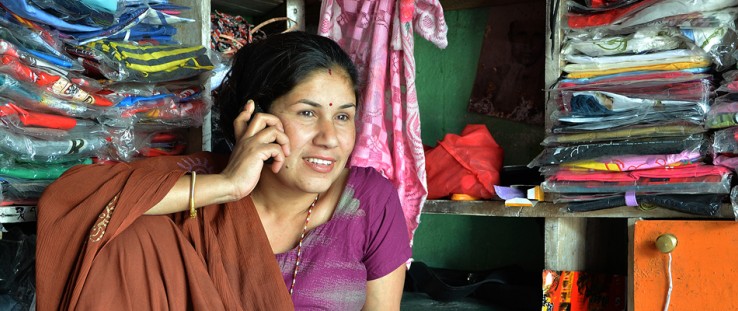 A small entrepreneur uses her mobile banking services to pay for her supplies.
USAID
A small entrepreneur uses her mobile banking services to pay for her supplies.
USAID
 A small entrepreneur uses her mobile banking services to pay for her supplies.
USAID
A small entrepreneur uses her mobile banking services to pay for her supplies.
USAID
Nepal’s mountainous terrains are stunning, but they pose real difficulties when it comes to connecting rural communities with banking services. Being able to store or transfer savings securely and conveniently, as well as access loans or insurance, can help households save time and money and get ahead.
Krishna Prasad Bhattarai is a micro-entrepreneur in the remote village of Thakurdwara in Nepal’s Bardiya district. His daughter is a student in the country’s capital, Kathmandu. There are no banks in Thakurdwara, and Bhattarai, like everyone else in his village, spent hours getting to the closest bank on his bicycle, or paying for a bus ticket to travel the roughly 15.5 miles. He was never comfortable having to travel with cash, but he needed to make sure his daughter received the money she depended on for monthly tuition and living expenses.
All that changed when mobile financial services, introduced with support from USAID, arrived in Thakurdwara in 2012. Now Bhattarai makes his deposits a few minutes’ walk away from his home by visiting an agent who transfers the money by using a basic cell phone’s text messaging service. No expensive smart phone or fancy app required. Access to banking services, right in his village, has eliminated the risk and time required to travel long distances with cash.
“Safety, reliability and convenience aside, the time I save is time I can now invest in my work,” Bhattarai said.
And although more than 70 percent of Nepalis are still disconnected from the formal financial sector, with new, innovative services launched with support from USAID, a growing network of mobile financial services could be available nationwide within five years.
Transforming the Cash Economy
Nepal remains one of the poorest countries in the world, with more than 57 percent of Nepalis earning less than $2 a day. Given the country’s challenging geography and lack of adequate road infrastructure, most banks remain centralized in and around urban centers. More than two-thirds of households do not have a formal account at a financial institution.
Without banking, households can’t save to buy equipment like tractors or tools like fertilizers or improved seeds. They can’t successfully adopt new farming technologies like multiple-use water systems or borrow money to invest in new business opportunities or find new jobs.
As a result, most poor households operate almost entirely in the cash economy. This means they use cash, physical assets (such as jewelry and livestock), or informal providers (such as money lenders and payment couriers) to meet their financial needs. These informal mechanisms, however, tend to be insecure, expensive and complicated.
If available at critical moments, effective financial tools for savings, payment, credit and insurance can help households climb out of poverty or weather a crisis or emergency without falling deeper into poverty.
While brick and mortar banks are a rarity in rural areas, cell phones are not. With over 70 percent of Nepal’s families—almost 19 million people—equipped with a mobile phone, USAID’s Nepal Economic Agriculture and Trade (NEAT) project recognized the potential of mobile financial services to reach the country’s predominantly unbanked households.
In 2011, USAID partnered with Mega Bank, a Nepali commercial bank, to help it establish branchless banking outlets using point-of-sale technology, and with Laxmi Bank, another Nepali commercial bank, to support the launch of a service that allows customers to make deposits, transfer or receive money, and take out loans through their phones.
A year later, in spring 2012, NEAT organized Nepal’s very first Mobile Financial Services Summit. That event generated much-needed momentum in the sector and led to increased interest, enthusiasm and action among bankers, financial service regulators, technological platform providers, and telecoms. Many ideas that had been discussed for years, but shelved due to the risks involved, came to life.
“USAID’s project adopted a very structured approach in helping banks. They first took steps to create enough awareness of mobile banking in the market,” said Suman Joshi, CEO of Laxmi Bank. “A group of bankers and regulators were taken on a study tour to Pakistan to get a hands-on experience of what was happening there. That was followed at the national level by a conference in Kathmandu which basically set the scene for mobile money in Nepal to take off.”
With USAID’s help, banks began to tap into rural markets and make products to answer their needs. “We now understand the rural economy much better and are much more confident in accessing those markets,” said Joshi.
Following the summit, a group of private banks came together to roll out mobile banking through a shared national technology platform that allows customers of one bank (or agents of that bank) to use services from another bank (or their agents) for the same fees or service. In a country with cut-throat competition among banks, where customers are charged for every service—especially those of a competing bank—this customer-centric system is one of a kind.
Today, the banks offering mobile financial services continue to gain experience, refine strategies and products, and adjust pricing to ensure successful growth. As mobile platform provider FinAccess’s founder and Nepali mobile financial services visionary Sanjay Shah notes: “Technology is not the innovation here in Nepal. The business model is the innovation.”
Indeed, FinAccess is the centerpiece of a consortium of six financial institutions using the same service, Hello Paisa. However, each bank brands its products to meet the needs of its customers. In Nepal, where banking is fragmented, this innovation—whereby banks collaborate to expand the customer base yet compete on services—has the potential to fuel a very rapid expansion of mobile financial services in the country.
“Today, banks are working together so that they can try to succeed individually, while also ensuring greater welfare and success of the individual and the society,” explained Sheila Lutjens, acting USAID/Nepal mission director. “Seeing the private sector really step up and take charge gives us an incredible amount of confidence in the sustainability of this product.”
Money in the Bank
As a result of USAID’s support, over 300 mobile financial services agents in 30 of 75 districts are currently operating in Nepal. These agents are typically credible, well-known individuals who run a shop or a small business in the village, and are identified and trained by the bank to serve as its business correspondent in previously untapped local markets. Through these agents, banks are now serving clients like Krishna Prasad Bhattarai and will reach more than 19,000 new clients this year alone. These new partners have disbursed over $2.3 million in rural loans to almost 8,000 borrowers, mostly women.
“It’s very simple: The mobile number is the customer’s mobile bank account and it enables customers to make financial transactions anytime and anywhere at their own command,” said Bhattarai. “The system saves both time and money, and eliminates the risk of carrying money in my pocket to deposit in the bank.”
The banks’ agents operating in rural markets can make deposits and withdrawals on behalf of bank customers. The bank provides a simple phone to its agents, which they use to connect directly with the bank’s system to verify customer ID and record transactions. The client, using his mobile phone PIN number, can transfer, deposit or withdraw money through the agent at little to no fee.
“USAID’s support not only helped our bank finally launch a product it had envisioned for years, but also served as the first real field experience for the entire banking industry on how mobile banking could work in Nepal,” said Nikesh Ghimire, a manager at Laxmi Bank. “Our experience created sufficient impetus for other banks to come on board.”
Approximately half of Nepal’s Gross Domestic Product (GDP) is outside the formal sector. In addition, many of the 70 percent of households without access to financial services save money “under the mattress.”
“An expansion of mobile financial services will draw more cash into the formal economy and increase the national savings rate. Banks will have more money to lend to businesses, giving a boost to overall GDP,” USAID’s Lutjens reinforced.
However, the country’s mobile financial sector still has important hurdles to cross. At a policy level, additional reforms are needed to ease regulations for signing up individuals. At the same time, commercial banks need to expand their area of coverage so that more remote households can access the network.
Despite these challenges, Nepali private sector leaders estimate that mobile financial services will reach all 75 districts of Nepal within five years, and make available new products such as insurance, health services and market information.
Laxmi Bank’s successful launch of mobile financial services, for instance, has generated significant interest from potential customers and the business sector. FinAccess, the company that developed the mobile platform used by the bank, recently doubled its capital, giving it the resources and the strategic partnerships required to ensure rapid scale-up of its services nationwide.







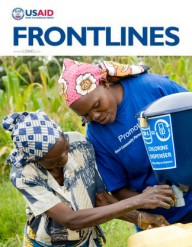

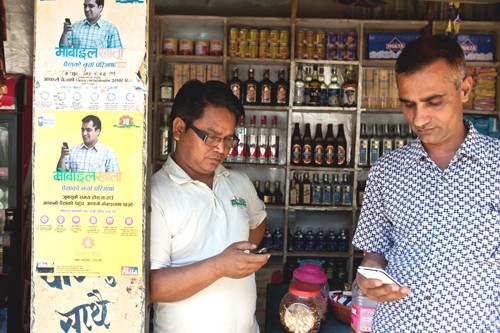
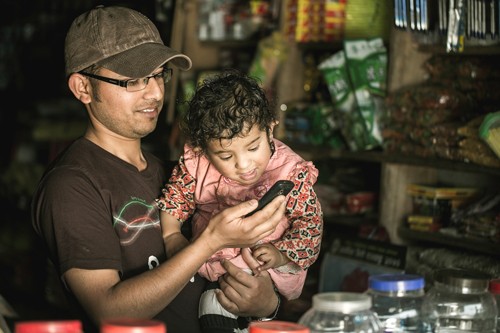
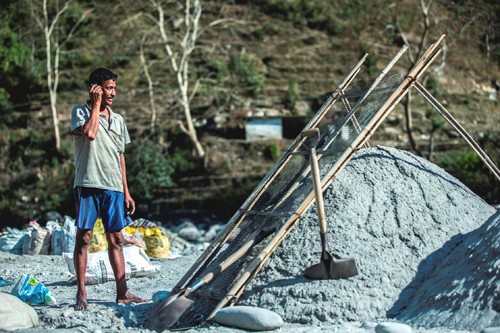
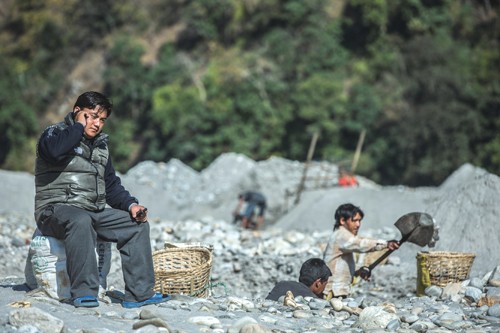

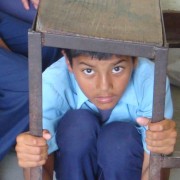
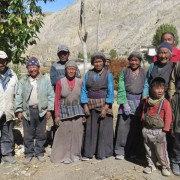
Comment
Make a general inquiry or suggest an improvement.